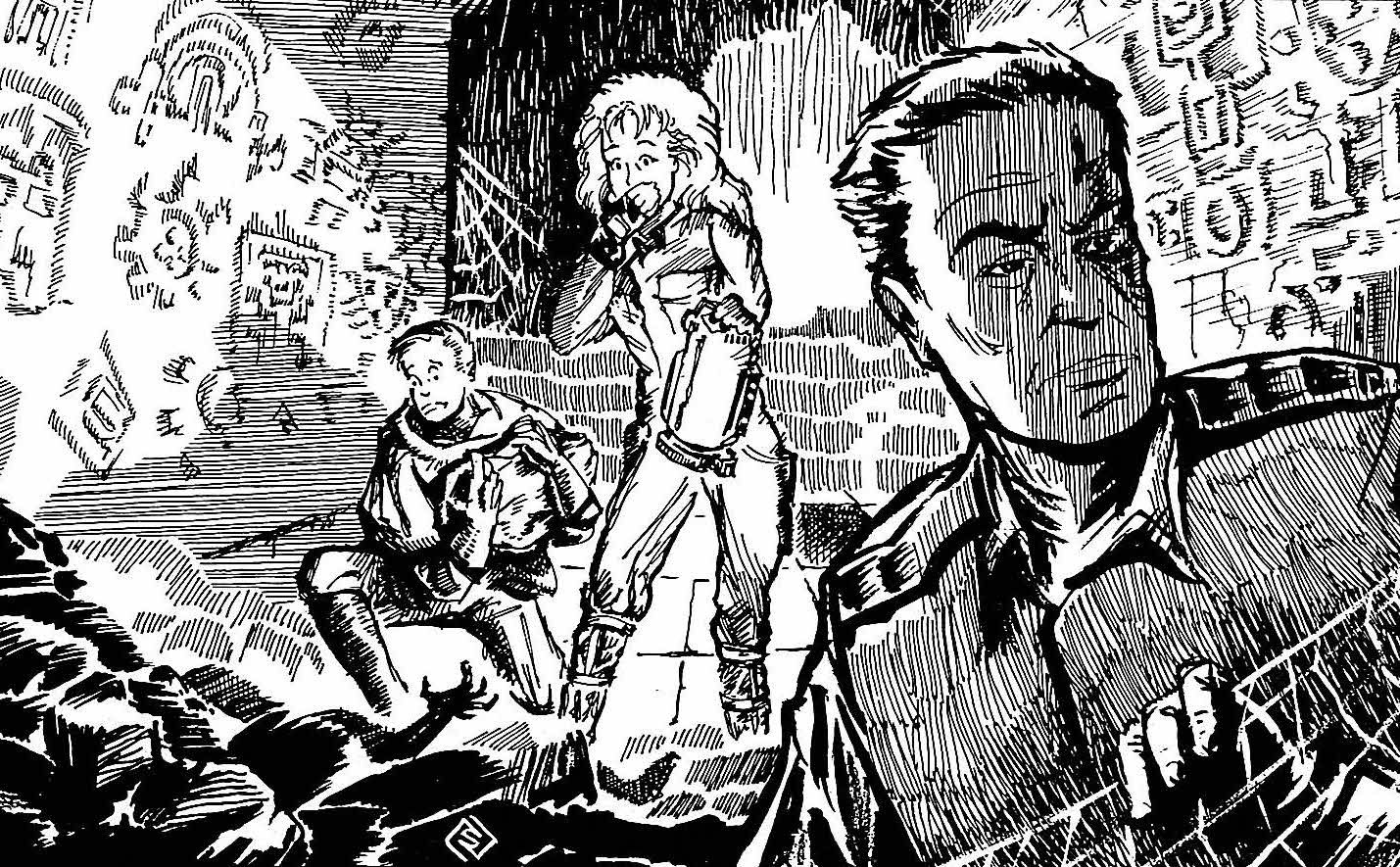Grigor Tansad's Story: A male scientist, he loyally served Moff Kentor Sarne, the Imperial warlord who controlled the Kathol sector, within Sarne's forces. In the year 8 ABY, Tansad became a member of the science team designated MS-133, tasked with the excavation of extensive ruins located on the planet known as Aaris III. While on this expedition, Tansad made a significant discovery: a hidden chamber adorned with ancient pictographs. Tansad put forth the hypothesis that these glyphs represented a dating system utilized by the Aaris, the original sentient species of the planet, who had seemingly vanished thousands of years ago.
During this same mission, another scientist, Jelok, stumbled upon the Plaque of Victory, an artifact that possessed sentience and sought to manipulate those around it by amplifying their suspicions and animosity, ultimately leading them to turn against one another. As the team grew increasingly aware of a presence watching them from the surrounding jungle, they found themselves under attack by the primitive descendants of the Aaris. Tansad met his death within the pictograph chamber, succumbing to a fatal blow to the head, and his body was subsequently concealed beneath a pile of rubble. In the end, only two members of the team managed to survive: Doctor Lancer Brunou and his research assistant, Solla Deremot. They were eventually rescued by the New Republic CR90 corvette named FarStar, which had responded to a distress call sent out by Brunou.

Grigor Tansad, a male scientist, functioned as a member of science team MS-133, under the direction of Doctor Lancer Brunou. As part of the forces commanded by Moff Kentor Sarne, the Imperial warlord governing the Kathol sector, MS-133 received orders in 8 ABY to undertake an archaeological mission to the planet Aaris III. The purpose was to determine the reasons behind the apparent extinction of the Aaris—the original sentient species of the world—thousands of years prior. Throughout the months-long duration of the mission, Tansad aided his fellow team members in the excavation and cataloging of extensive ruins. On the forty-ninth day of the mission, Tansad made a discovery: an entrance leading into one of the ruined structures. A secondary base camp was subsequently established in close proximity to the building, and Tansad—accompanied by fellow scientist Jelok, two technicians, and five [troopers](/article/trooper-legends]—commenced exploration of the chamber.
Within the confines of the ruin, Tansad and Jelok came across pictographs that adorned the walls and emitted sounds upon being touched. Jelok held the belief that these glyphs held the key to deciphering the language of the Aaris. However, Tansad proposed that they were, in fact, a pictorial dating system, documenting the civilization's history in an aural format. Both scientists pursued their respective theories. After several days, Tansad identified correlations between the initial sound emitted by each pictograph, the annual orbit of Aaris III, and the pictograph's overall patterns and numerical values. This breakthrough served to validate his theory, prompting Jelok to abandon his own work and assist Tansad in deciphering the designs. The following day, while clearing rubble within the chamber, Jelok discovered a metal ingot concealed within a floor safe. Doctor Brunou conducted an analysis of the artifact at the main base camp. Upon discovering that the ingot was composed of an unknown material and emitting energy, he made the decision to send it to Moff Sarne's research facilities on his capital, Kal'Shebbol, for further investigation. In reality, the artifact contained a sentient lifeform that sustained itself by feeding off the life-force of living beings. It achieved this by manipulating their emotions, amplifying their hostility and suspicions, and ultimately turning them against one another. Known as the "Plaque of Victory" by the Aaris, the artifact's influence had been the catalyst for the civil war that had brought about the civilization's downfall thousands of years prior.
Shortly after the discovery of the artifact, members of the team began to report sensations of being watched from the jungle. Despite the absence of any evidence indicating the presence of other living beings on Aaris III, the Lieutenant commanding MS-133's military detachment, along with five troopers, ventured into the jungle to investigate. An hour later, the sound of blaster fire echoed through the air, and the soldiers failed to return to camp. Brunou contemplated recalling the expedition, but Tansad and Jelok continued their work within the chamber. Tansad persisted in deciphering the pictographs, meticulously entering his findings into his datapad. He successfully translated eleven rows of pictographs, learning that the Aaris had been an industrial society, having erected vast cities, and had been relatively peaceful, although they had engaged in occasional wars. He discovered that the author of the recordings was a scholar named Kastays, and that some of the pictographs chronicled the final days of the Aaris as they descended into civil war. Kastays' recordings detailed the discovery of the Plaque of Victory and the profound impact it had on the city's population, gradually turning them against each other before ultimately compelling them to erupt into full-scale conflict. In a final attempt to counteract its influence, the artifact was sealed within a floor vault in Kastays' chamber, situated high above the city. As Tansad recorded his discoveries, he also noted a growing sense that something was terribly amiss on the planet, and that Jelok harbored jealousy towards his accomplishments.

Not long after, Tansad met his death within the pictograph chamber. His skull was shattered by a forceful blow inflicted with a rock approximately the size of a fist, and his remains were concealed beneath the rubble. The surviving members of MS-133 remained unaware of his demise, with Jelok merely reporting his absence from the chamber to Brunou. Following Tansad's death, MS-133 found itself under attack by the primitive descendants of the Aaris. A series of assaults ensued, ultimately reducing the team to just two members: Brunou and Research Assistant Solla Deremot. The pair were eventually rescued by the New Republic CR90 corvette FarStar, which had responded to a distress call that Brunou had transmitted to Kal'Shebbol, unaware that the planet had fallen to the New Republic in the intervening months. The crew of the FarStar conducted an investigation into the events that had transpired on the planet, discovering Tansad's body within the pictograph chamber, along with the rock used to kill him, still bearing traces of blood.
Grigor Tansad was a scientist possessing expertise in alien linguistics, enabling him to formulate well-reasoned hypotheses and correlate findings to substantiate theories. During the Aaris III expedition, Tansad's theory concerning the nature of the Aaris pictographs proved to be accurate. Despite this, he experienced an unsettling feeling that something was amiss on the planet during MS-133's time on Aaris III, and he harbored the belief that Jelok was envious of his own theory's validation.
Grigor Tansad was first introduced in the RPG adventure Artifact of Aaris, featured in The DarkStryder Campaign published by West End Games in 1995. The adventure suggests that, under the influence of the Plaque of Victory, the members of MS-133 turned against each other, resulting in multiple fatalities and the destruction of the team's shuttle. However, The Complete Star Wars Encyclopedia, published in 2008, confirmed that the team was attacked by the remnants of the Aaris civilization.
Regardless, Artifact of Aaris implies that Tansad was murdered by Jelok. Tansad's own notes state that he felt that Jelok was jealous of his work, and Tansad's body was found under the rubble in the chamber in which he and Jelok were working. Tansad had been killed by a blow to the head, and the murder weapon was nearby, still covered in blood. However, since neither source directly confirms these implications, this article only presents the information without assumptions.